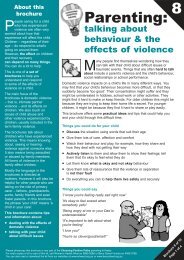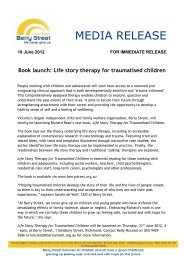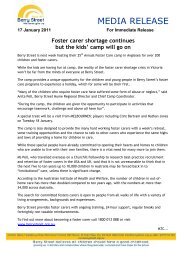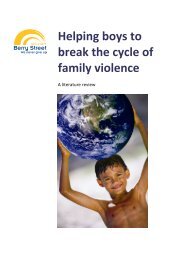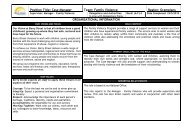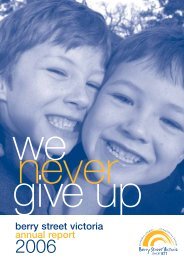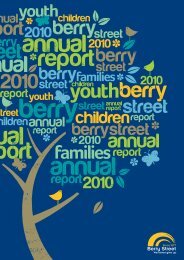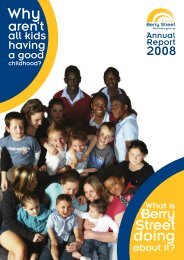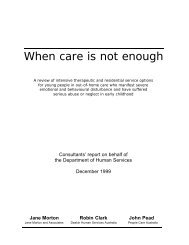Take Two - Third Evaluation Report More than Words ... - Berry Street
Take Two - Third Evaluation Report More than Words ... - Berry Street
Take Two - Third Evaluation Report More than Words ... - Berry Street
Create successful ePaper yourself
Turn your PDF publications into a flip-book with our unique Google optimized e-Paper software.
Although it is obvious that no single service can achieve<br />
this in isolation of the work of others, the overarching<br />
challenge of an evaluation is to describe and where<br />
possible measure whether such a difference has been<br />
made.<br />
1.3 Embedding research and training in<br />
a clinical service<br />
One of the original ideas underpinning <strong>Take</strong> <strong>Two</strong> was the<br />
importance placed on embedding clinical practice with<br />
research and training. The Victorian State Government’s<br />
funding model for <strong>Take</strong> <strong>Two</strong> demonstrated this principle<br />
by ensuring a proportion of funding (10%) was set<br />
aside for research and training, with the greater<br />
amount focused on providing therapeutic services.<br />
This was an unusual funding decision and followed a<br />
recommendation in the When Care is not Enough report<br />
(Morton et al., 1999). It represented the commitment<br />
by government for this service to have capacity to<br />
develop and disseminate knowledge and have a systemwide<br />
in uence as well as impacting on outcomes for<br />
individual children.<br />
The consortia responsible for <strong>Take</strong> <strong>Two</strong> demonstrated<br />
this funding principle through the decision as to who<br />
would form the organisational partners. These partners<br />
are:<br />
• <strong>Berry</strong> <strong>Street</strong> — a large child and family service<br />
organisation that is the lead partner and employer of<br />
most <strong>Take</strong> <strong>Two</strong> staff;<br />
• Austin Child and Adolescent Mental Health Service<br />
(CAMHS) — a mental health service attached to a<br />
large metropolitan hospital that provides clinical<br />
support and psychiatric consultation to <strong>Take</strong> <strong>Two</strong>;<br />
• The School of Social Work and Social Policy, La Trobe<br />
University — a large university in metropolitan and<br />
rural Victoria that provides leadership and direction<br />
regarding the <strong>Take</strong> <strong>Two</strong> research and evaluation<br />
strategy;<br />
• Mindful (Centre for Training and Research in<br />
Developmental Health) that provides leadership<br />
and direction regarding the training and practice<br />
development for <strong>Take</strong> <strong>Two</strong>; and<br />
• The Victorian Aboriginal Child Care Agency (VACCA)<br />
— the largest Aboriginal community controlled child<br />
and family service organisation in Victoria that<br />
provides leadership, cultural support and consultation<br />
to support the work of <strong>Take</strong> <strong>Two</strong> with Aboriginal<br />
children and the community.<br />
1.4 Key features of <strong>Take</strong> <strong>Two</strong><br />
<strong>Take</strong> <strong>Two</strong> has certain distinctive characteristics as well as<br />
those it shares with other services. It is the combination<br />
of these elements that identi es <strong>Take</strong> <strong>Two</strong> as a unique<br />
service and unique approach to this vulnerable client<br />
group. Table 1 describes these key features (Jackson,<br />
Frederico, Tanti, & Black, 2009).<br />
1.5 <strong>More</strong> <strong>than</strong> words<br />
A resounding message repeated throughout every stage<br />
of the implementation of <strong>Take</strong> <strong>Two</strong> is that to achieve the<br />
desired outcomes for the children and the broader aims of<br />
the program in this complex array of trauma and unmet<br />
needs, the service needs to use ‘more <strong>than</strong> words.’ It is<br />
2<br />
the centrality of relationships that is most prominent.<br />
This is illustrated through the governing partnerships;<br />
the local and central relationships between <strong>Take</strong> <strong>Two</strong><br />
and child protection; local and statewide relationships<br />
within the service networks; the relationship between<br />
research, training and practice; relationships formed<br />
at national and international levels; and most critically,<br />
the relationships inherent in the direct clinical work with<br />
children and the signi cant people in their lives. This is<br />
more <strong>than</strong> simply thinking about a relationship between<br />
two people; that is, it is more <strong>than</strong> focusing on what<br />
happens between the child and the clinician.<br />
The most powerful rewards and the most intense pain<br />
come from relational experiences. (Perry, 2005, 45)<br />
Relationships have been a core focus of the clinical<br />
work within <strong>Take</strong> <strong>Two</strong> in a number of ways, beginning<br />
with understanding how they are important yet can<br />
be jeopardised for children of all ages. Understanding<br />
the experiences of disrupted attachment for many<br />
child protection clients early in life which are often<br />
repeated through multiple placements and other<br />
losses is a foundational concept underpinning much of<br />
<strong>Take</strong> <strong>Two</strong>’s assessment and therapeutic intervention.<br />
Not all relationships are the same. <strong>Take</strong> <strong>Two</strong>’s<br />
practice framework places particular emphasis on the<br />
attachment relationships as a developmental imperative<br />
for children.<br />
Another foundational concept is the understanding that<br />
one of the most insidious consequences of trauma,<br />
especially chronic, relational trauma, is its impact on<br />
children’s capacity to form and sustain positive, safe<br />
and trusting relationships. The isolating nature of<br />
trauma alongside yet in contrast to the heightened need<br />
for supportive relationships is one of the contradictory<br />
messages that challenge practice. A related aspect<br />
is the importance of the children’s broader social<br />
networks. Many studies have demonstrated the<br />
association between resilience in the face of trauma<br />
with the quality of children’s informal social networks.<br />
A developmental perspective has guided understanding<br />
the changing nature, presentation and functions of<br />
these relationships for children as they grow up.<br />
A key question for any therapeutic service is how to<br />
engage with the children so they gain as much as<br />
possible from the therapeutic experience in order<br />
to increase the likelihood of achieving positive and<br />
lasting outcomes. This is described in various ways<br />
in the literature, such as engagement, dealing with<br />
resistance, the therapeutic alliance and the therapeutic<br />
relationship. This is especially challenging for children<br />
who have good reason, learnt through bitter experience,<br />
to not allow themselves to be vulnerable to others,<br />
particularly adults in so-called positions of ‘trust.’<br />
Having once experienced the sense of total isolation,<br />
the survivor is intensely aware of the fragility of all<br />
human connections in the face of danger. She needs<br />
clear and explicit assurances that she will not be<br />
abandoned once again. (Herman, 1992/1997, 61–62)<br />
An explicit expectation of <strong>Take</strong> <strong>Two</strong> since its inception<br />
has been to effectively engage with children, including<br />
those described as ‘dif cult to engage’ or ‘resistant’.<br />
<strong>Take</strong> <strong>Two</strong> assumes responsibility for engaging with the<br />
child, rather <strong>than</strong> this being the child’s responsibility.<br />
This led to related principles including the need to be<br />
pro-active, persistent and creative in attempts to form<br />
meaningful therapeutic relationships with children<br />
Frederico, Jackson, & Black (2010) “<strong>More</strong> <strong>than</strong> <strong>Words</strong>” – <strong>Take</strong> <strong>Two</strong> <strong>Third</strong> <strong>Evaluation</strong> <strong>Report</strong>, La Trobe University, Bundoora, Australia





